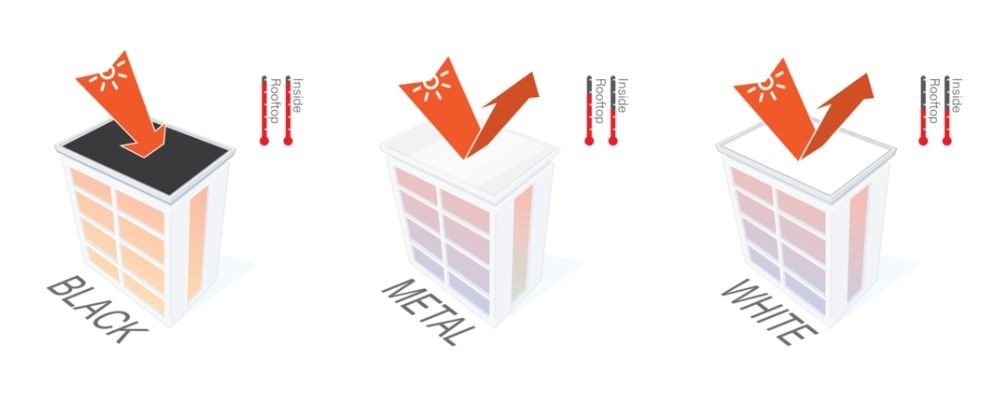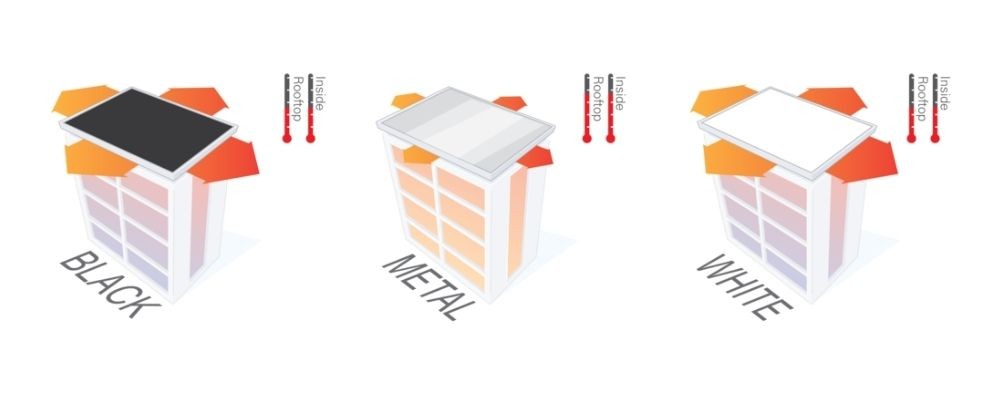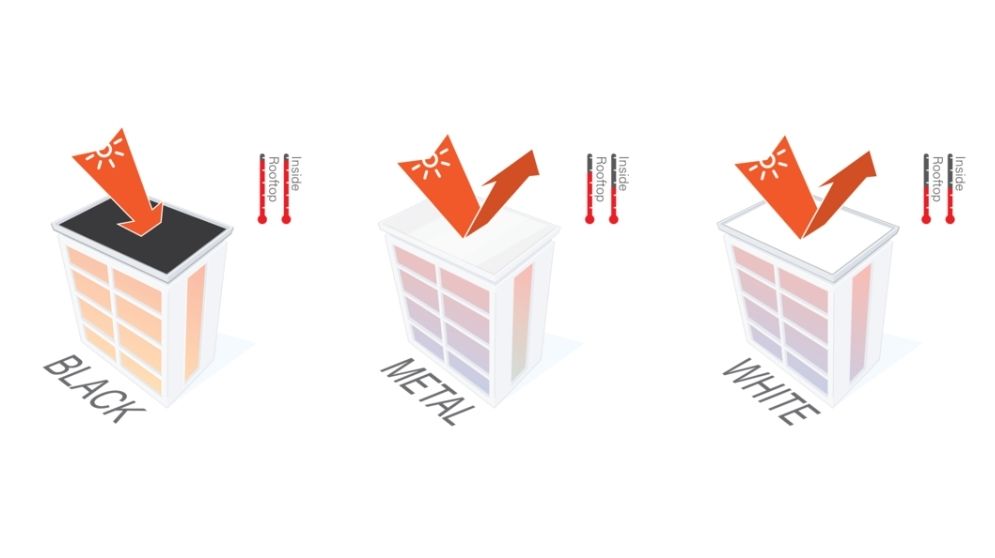When looking at energy efficiency and environmental impacts of buildings, there is one simple but sometimes overlooked feature that can be readily addressed—namely, the color of the roof. Why is color important? Because basic physics tells us that when sunlight falls on a dark surface a large portion of the energy is absorbed into the material and it retains heat. If it falls onto a lighter-colored, reflective surface, then a large portion of the sunlight’s energy is bounced back into the atmosphere, minimizing the heat that is absorbed. This is the reason a dark-colored parking lot feels hotter than a reflective surface next to it on a sunny summer day. The dark paving is absorbing the sun’s rays and heating up, while the lighter surface is not. Since physics doesn’t discriminate between materials, dark and light roofing works the same way.
There are two fundamental principles of heat flow that are relevant here:

Solar Reflectivity, which is the ability of a material to reflect the sun's energy back to the atmosphere.

Thermal Emissivity, which is a material's ability to shed, not retain, heat.
Recognizing these fundamental principles, standards that seek to reduce the environmental and energy impact of buildings (i.e., energy codes, LEED rating system, etc.) see any excess heat as an unwanted by-product to be mitigated. While the heat may be welcome in winter, the reality is that many commercial buildings use more energy for air conditioning than for heat.
The impact of the extra heat can be looked at in at least three ways. First, as the heat radiates up from the building, it begins to warm the surrounding air. That means the localized air temperature goes up, sometimes noticeably. Some claim that if there are other buildings nearby—as in an urban setting—that also have dark roofs, then their collective excess heat can raise the temperature of a larger area to create a “heat island” in the midst of that larger area with otherwise normal temperatures. Second, the building enclosure is the division between the outdoor elevated heat temperature and the interior conditioned space. With more heat to resist during the cooling season, the air conditioning system needs to run more to keep the interior comfortable. Keep in mind that the heat not only comes through the glass in windows or the construction of the walls and roof, but also in through the air that is used to ventilate commercial buildings. If that air is warmer than typical, then extra cooling is needed to bring it in line with the air temperature inside. This all means that the building owner is paying more to purchase more electricity to run the air conditioning and related systems. Of course, the third way to look at dark roofs generating some heat could be seen as a benefit in cold climates, where the added warmth would be welcome.
Fortunately, the building construction industry has developed some ways to know ahead of time how absorptive or reflective different roofing materials will be when they are installed. All materials will absorb and reflect varying amounts of solar radiation based primarily on the color and reflectance of the surface of a material. The way to measure that variation is based on ASTM standards E903 and E892 to determine what they define as the solar reflectance (SR) of materials. The SR is expressed as the portion (essentially the percentage) of solar energy that is reflected on a scale of zero to 1—an SR rating of 0.0 means there is no reflectance, while an SR rating of 1.0 represents full reflectance. Most materials fall somewhere in between, so a material that tests as half absorptive and half reflective, for example, would be represented by an SR rating of 0.5. This can also be shown as a percentage, in this case 50 percent.
Even more specific to roofing materials, the Solar Reflectance Index (SRI) has been developed as a measure of the ability of a roof surface to stay cool in the sun. This index begins with the SR value of the roofing material, but adds in a value for how much thermal energy is emitted from the material. It relies on a separate ASTM E1980 standard plus values from the Cool Roof Rating Council Standard (CRRC-1). The resulting SRI is reported on a scale of 0 (black absorptive surface) and 100 (white reflective surface)—the higher the SRI, the higher the amount of solar radiation that is reflected and thermal radiation minimized, thus creating a comparatively cool roof surface.
Choosing roofing materials with the appropriate SR and SRI ratings for the climate, paired with the right amount of insulation, can help control the amount of heat entering a building and save on energy costs. To find out more about roofing products that do just that, contact your Johns Manville representative.

